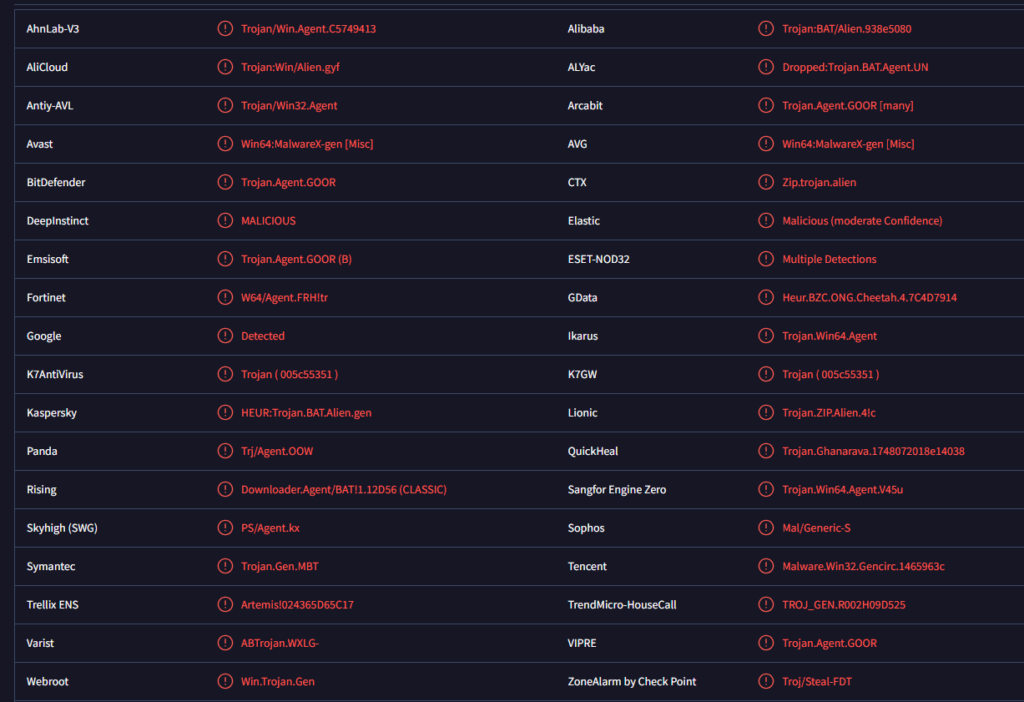Remove Noodlophile stealer trojan
Noodlophile is a stealer trojan that aims to extract and steal highly sensitive information from users’ computers, including stored passwords, browser information (e.g., cookies), saved payment card details, etc. It’s a very dangerous type of infection that may stay in the background to avoid detection and steal as much information as possible. The operators of this stealer trojan are taking advantage of users’ interest in generating AI videos/audio content, as it’s disguised as AI tools and promoted on social media sites like Facebook. However, that is just one way it’s being distributed. Noodlophile stealer trojan is offered as a MaaS (Malware-as-a-Service), meaning malicious actors can pay to use it and choose different ways to distribute it.
Stealer trojans like Noodlophile pose a significant threat as they target personal and sensitive information. These infections are particularly sophisticated, use various sneaky techniques to infiltrate devices unnoticed, and operate discreetly in the background. This allows them to collect large amounts of data over time. The stolen information is then transmitted to the cybercriminals behind the trojan, who may use it themselves or sell it to other malicious actors. Either way, the information will be used against users.
Noodlophile can extract data from various web browsers. That includes browsing histories, internet cookies, auto-filled data such as usernames, and other personal information like passwords and credit card details. It also functions as a keylogger, aiming to capture login credentials for social media and email accounts. By hijacking these accounts, cybercriminals can spread malware further, promote scams, or deceive victims into transferring money. Additionally, it can target cryptocurrency wallets, stealing their login details and potentially leading to significant financial losses.
To effectively steal information, stealer trojans like Noodlophile must remain hidden as long as possible. Users without anti-malware protection may not realize their device is infected, as these trojans often don’t show obvious signs of their presence. Thus, having a dependable anti-malware program is essential. It can detect and eliminate the Noodlophile trojan before it begins its harmful activities.
How did the Noodlophile stealer trojan get into the computer?
The cybercriminals behind the Noodlophile are distributing the malware in several different ways. Because different cybercriminals may operate it, the distribution method will change. One way it’s being spread is by taking advantage of users’ interest in AI-generated videos and content. Malicious actors promote malicious links to fake AI platforms on social media, and when users download content from them, they end up with malware, specifically this Noodlophile stealer trojan.
There are several other common methods through which malware can be distributed, including email attachments, malicious links, phishing campaigns, and torrents. Users who have good browsing habits are significantly less likely to fall victim to malware infections, as they take essential precautions while online. Developing safer online habits is a proactive approach to defending against trojans and other types of malware in the future.
Email attachments rank among the most prevalent methods for spreading malware, making it vital to know how to identify harmful emails. Malicious files are often included in emails that imitate legitimate communications from businesses and services. Opening these attachments can lead to infections, and if the malware is intended to steal information, users might remain unaware of the threat. Typically, these harmful emails are quite generic unless they target specific individuals or organizations. These generic emails are usually easier to spot because they have many spelling and grammar mistakes that stand out, especially when the sender falsely claims to represent a legitimate entity.
Additionally, malicious emails frequently use vague terms like “User,” “Member,” or “Customer” when addressing recipients. In contrast, legitimate companies tend to include personal details in their communications, often addressing customers by name for a more personalized touch. If you receive an unsolicited email from a company that should know your name but instead uses generic greetings, it’s likely spam or malicious.
On the other hand, targeted malicious emails can be quite sophisticated. They often lack mistakes, contain credible information, and usually greet recipients by name. To safeguard yourself from inadvertently opening harmful attachments, it’s a good idea to scan unsolicited email attachments using anti-malware software or services like VirusTotal.
Lastly, torrents can also carry malware. It’s common knowledge that many torrent sites have inadequate moderation, allowing malicious users to upload infected torrents that may remain downloadable for a while. Torrents for movies, TV shows, and video games are often full of malware. Users should understand that downloading copyrighted material for free not only violates copyright laws but also poses significant risks due to the potential for malware infections.
Remove Noodlophile stealer trojan
To remove Noodlophile stealer trojan, you need to use a reputable anti-malware program. These types of infections can be quite sophisticated, making a professional tool necessary for effective removal. If you haven’t installed an anti-malware program, you might not even realize that your device is infected.
If your anti-malware software detects the Noodlophile stealer trojan, it is likely that some of your personal information has been compromised. In such a case, it’s crucial to protect your sensitive accounts by changing your passwords and enabling multi-factor authentication.
Site Disclaimer
WiperSoft.com is not sponsored, affiliated, linked to or owned by malware developers or distributors that are referred to in this article. The article does NOT endorse or promote malicious programs. The intention behind it is to present useful information that will help users to detect and eliminate malware from their computer by using WiperSoft and/or the manual removal guide.
The article should only be used for educational purposes. If you follow the instructions provided in the article, you agree to be bound by this disclaimer. We do not guarantee that the article will aid you in completely removing the malware from your PC. Malicious programs are constantly developing, which is why it is not always easy or possible to clean the computer by using only the manual removal guide.

